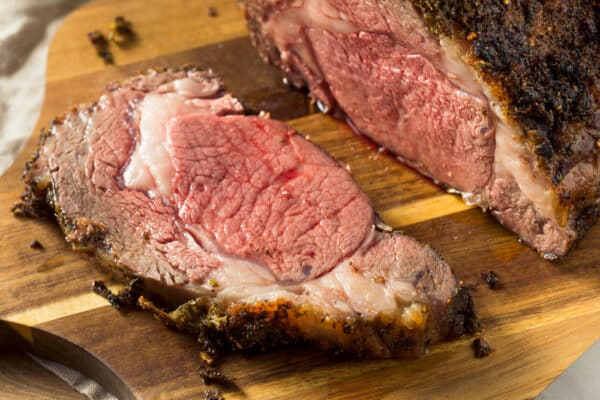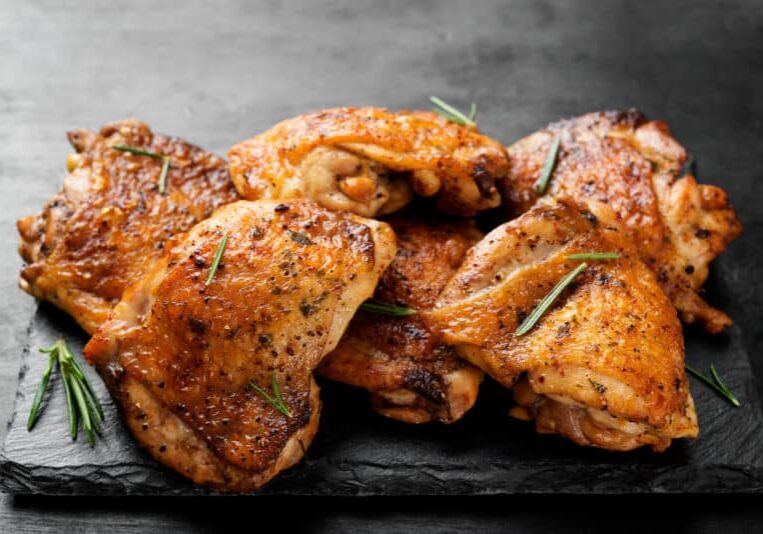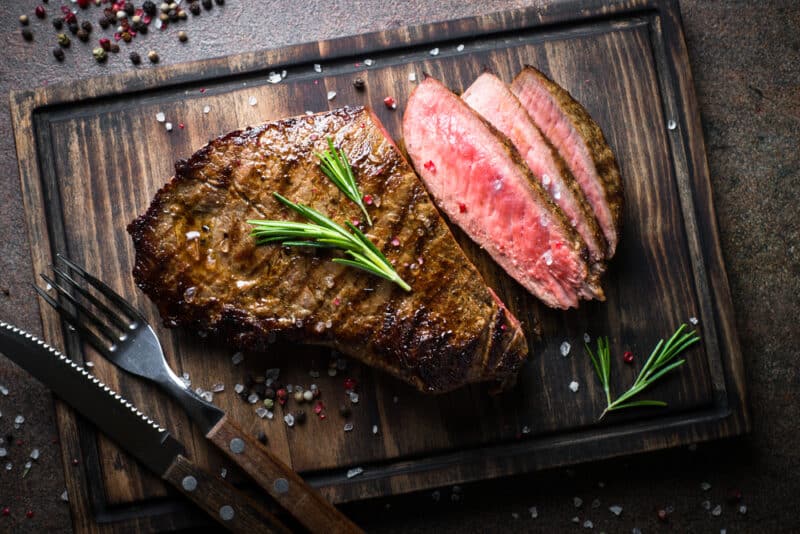Smoked Prime Rib [Cooking Guide]
TheGrillingMaster.com is reader-supported. If you buy something using the links on our site, we might earn an affiliate commission at no added cost to you. This helps us pay our staff to keep making awesome content for you!

Smoking prime rib involves several steps that ensure a succulent and flavorful result. Start by selecting a quality prime rib roast, ideally USDA Prime grade or better.
Apply a simple dry rub composed of your favorite herbs and spices, or use a mixture of salt, pepper, and garlic powder. Prepare your smoker and heat it to a temperature of around 225°F (107°C).
Place your prime rib in the smoker, bone side down.
Smoke the prime rib for about 3-4 hours, or until the internal temperature reaches 120°F (49°C) for a rare roast, or 130°F (54°C) for medium-rare.
Once it’s reached the desired temperature, remove the prime rib from the smoker and let it rest for about 20-30 minutes before carving. Use tinfoil to create a tent that keeps your prime rib warm while it’s resting. This allows the juices to redistribute throughout the roast, leading to a moist and tender result.
Choosing the Right Cut
When I set out to smoke a prime rib the first thing I consider is the quality of the cut. I’m a firm believer that the quality of your meal begins with the quality of your ingredients, and this is especially true when it comes to meat.
The grading of meat is something every BBQ enthusiast should understand. The USDA grades beef based on both quality and the amount of marbling.
USDA Prime is the highest grade and it’s what I typically aim for when smoking prime rib.
This cut is well-marbled, and it’s this marbling that keeps the meat tender and flavorful throughout the smoking process. But don’t be disheartened if Prime isn’t within your budget; USDA Choice is still high quality and the next best thing. The leanest grade, Select, can also produce a tasty prime rib if handled with care.
The next decision I make is whether to opt for bone-in or boneless prime rib.
For me, bone-in is the traditional choice and often yields the best flavor.
The bones act as natural insulators, helping to distribute heat evenly and retain moisture. However, if you’re looking for convenience, especially when it comes to carving, a boneless roast may be a better choice. It also allows for easier and more uniform application of rubs and seasonings.
Finally, I think about the size of the prime rib I need.
Prime rib roasts are usually sold as “standing rib roasts”, ranging from 2 to 7 ribs.
I typically estimate that one rib will feed about two people. So, if I’m entertaining a large crowd, a seven-rib roast might be on the menu. For smaller gatherings, a two or three-rib roast is usually plenty.
But keep in mind, the capacity of your smoker will also play a role in the size of the roast you choose.
In my experience, taking the time to select the right prime rib cut sets me on the path to success. It’s the first and one of the most important steps in creating a smoked prime rib that leaves my guests asking for seconds and thirds.

Preparing Your Prime Rib
Once I’ve chosen my prime rib cut, it’s time to turn my attention to preparing it for the smoker. This step, I’ve found, can elevate a good smoked prime rib into something truly exceptional.
Trimming is the first task in this process. Often, my butcher has done a fine job of this already, removing any excess fat and leaving just the right amount behind to enhance flavor.
However, if there is still a substantial fat cap on the roast, I trim it down to about a quarter of an inch. This ensures that my dry rub can permeate the meat properly and prevents the outer layer from becoming overly greasy.
Next, I focus on the dry rub.
Over the years, I’ve experimented with a variety of blends, but I’ve found that a simple mixture of salt, pepper, and garlic powder allows the rich flavors of the prime rib to shine through.
That said, I encourage you to personalize your rub.
Consider adding rosemary for a hint of piney freshness, or a sprinkle of smoked paprika for an added layer of smokiness. Whatever you choose, apply the rub liberally over the entire surface of the prime rib. I make sure to work the rub into the meat, ensuring that every nook and cranny is covered.
Then comes the question of marinating.
It’s a debated topic amongst pitmasters.
Personally, I’ve found that a good quality prime rib, especially if it’s well-marbled, doesn’t require a marinade.
The natural flavors of the beef, enhanced by the smoke and the dry rub, are often sufficient.
If you do decide to marinate your roast, a simple concoction of olive oil, garlic, and fresh herbs can add a delightful complexity to your smoked prime rib.
In my experience, dedicating time to prepare the prime rib properly is time well spent. Because it lays the groundwork for the smoking process and sets you on a path to create a mouthwatering, smoked prime rib that’s bursting with flavor.

Setting Up Your Smoker For Prime Rib
Once I’ve meticulously prepared my prime rib, the next vital step is setting up my smoker.
Over the years, I’ve learned that a properly prepared smoker is key to a perfectly smoked prime rib.
There are various types of smokers available, each offering unique benefits.
For me, a traditional wood smoker is the most rewarding.
It demands a bit more attention and finesse, but the deep, complex flavors it imparts make it well worth the effort. However, if convenience is a top priority, electric or propane smokers can be a great choice.
They maintain a consistent temperature with little effort, leaving you free to focus on other aspects of your BBQ.
The choice of wood is another critical factor in smoking prime rib. Different types of wood impart different flavors, and pairing your meat with the right wood can elevate your dish.
For beef, and especially for a cut as flavorful as prime rib, I often lean towards oak or hickory. Both offer a robust, slightly sweet smoke that complements the beef beautifully. If I’m aiming for a milder, sweeter flavor, fruit woods like apple or cherry can be a delightful choice.
Related Reading: See how much prime rib you need per person.
When it comes to heat management, I always remind myself that ‘low and slow’ is the mantra for smoking.
Maintaining a consistent temperature around 225°F allows the prime rib to cook slowly and evenly.
[PRO TIP] I’ve learned the hard way that temperature fluctuations can lead to an unevenly cooked prime rib, or worse, a dry and tough one. I use a good quality, reliable thermometer to monitor my smoker’s temperature throughout the cooking process.
Setting up your smoker correctly sets the stage for a successful smoking session. It may take a bit of time and patience, but I can assure you that it is well worth the effort.

Smoking your Prime Rib
With the smoker set up and the prime rib prepared, it’s time for the main event: smoking the prime rib.
This stage is a blend of art and science that I’ve fine-tuned over the years, and it’s where all the preparation comes together.
To start, I place the prime rib in the smoker, bone side down.
The bones act as a natural heat shield, helping to protect the meat from the intense heat at the bottom of the smoker. I position the meat in the middle of the grill, away from any direct heat sources. This indirect heat method ensures the prime rib cooks slowly and evenly.
Now comes the test of patience.
The phrase ‘low and slow’ isn’t just a mantra; it’s the golden rule.
For a prime rib, a smoking temperature of around 225°F is ideal.
It can be tempting to increase the heat to speed up the process, but patience truly pays off when smoking. I usually estimate about 3-4 hours of smoking time, but this can vary depending on the size of the roast and the consistency of the smoker temperature.
A crucial tool in my smoking arsenal is a meat thermometer.
I prefer the digital, probe-style thermometers that can stay in the meat throughout the smoking process. These allow me to monitor the internal temperature of the prime rib without opening the smoker and losing heat.
For a rare roast, I pull the meat out at an internal temperature of about 120°F. For medium-rare, I aim for 130°F. Remember, the temperature will continue to rise a bit during the resting period.
One of the many beautiful aspects of smoking prime rib is the natural flavor of the meat, enhanced by the dry rub and smoke, which means I don’t need to baste or rotate the roast. It’s a more hands-off approach, letting the smoker do most of the work.
Smoking the prime rib is a process that requires time, attention, and, most importantly, patience. But when you finally take that first bite of tender, smoky, succulent prime rib, you’ll realize that every moment spent was worth it.
It’s a gastronomic journey I relish each time, and I hope you will too.
I like to use a string to keep the roast held together tightly, and recommend you do the same.

Resting and Carving Your Prime Rib
After I’ve carefully monitored the smoking process and my prime rib has reached the desired internal temperature, it’s time for what might seem like an easy step, but one that I’ve learned is crucial to the final result: resting and carving.
Resting is the most underestimated yet essential part of the process.
It can be tough to resist immediately cutting into that beautifully smoked prime rib, especially when the aroma fills the air. But over time, I’ve learned that patience during the resting period is a virtue that pays off.
The resting period allows the juices to redistribute throughout the roast, resulting in a moist, tender, and flavorful prime rib.
I typically let my prime rib rest for about 20-30 minutes, loosely covered with foil to retain heat and keep it warm.
Carving the prime rib is the final step before serving, and doing it right can enhance the eating experience.
If I’ve gone for a bone-in prime rib, I start by removing the bones. I carefully slice along the contour of the bones, detaching them in one piece, which can later make for some delicious beef ribs.
Then, it’s time to slice the roast.
A long, sharp knife is my tool of choice, and I always slice against the grain.
This breaks up the muscle fibers, ensuring each bite is as tender as possible. The thickness of the slices depends on personal preference, but I aim for about 1/2 inch to 3/4 inch thick slices, which I find offers the perfect balance of tenderness and portion size.
Serving a perfectly smoked prime rib isn’t just about the cooking process; it’s also about how you let it rest and how you carve it.
Remember, patience is your best friend, both during resting and when you’re waiting to carve and serve.
When you finally present that beautifully cooked, expertly sliced prime rib to your guests, you’ll see that all your hard work and patience have truly paid off.

Sides and Pairings
ow, with the star of the show – the smoked prime rib – ready to serve, I shift my focus to the supporting cast: the side dishes and pairings. They are equally important to create a balanced and harmonious meal that complements the flavors of the smoked prime rib.
Over the years, I’ve found that simple, well-executed sides often pair best with smoked prime rib. Creamy mashed potatoes, for instance, are a classic choice. The creaminess of the potatoes pairs wonderfully with the smoky, rich flavors of the beef. For an added touch of indulgence, I sometimes stir in a bit of truffle oil.
A crisp, green salad is another excellent accompaniment. The fresh, crunchy greens help to cut through the richness of the prime rib, adding a refreshing element to the meal. I often toss in some radishes for a peppery bite, and a simple vinaigrette adds just enough acidity to balance the flavors.
Roasted vegetables, too, make for a great side dish. I love roasting seasonal vegetables with a bit of olive oil, salt, and pepper. The high heat caramelizes the sugars in the vegetables, bringing out their natural sweetness that contrasts beautifully with the savory prime rib.
When it comes to pairings, I typically turn to a bold, full-bodied red wine. A Cabernet Sauvignon or a Syrah, with their dark fruit flavors and firm tannins, are robust enough to stand up to the rich, smoky flavors of the prime rib. For beer lovers, a dark, malty beer like a stout or porter can be a delightful match.

10 Side Dishes that Go Great with Prime Rib
-
Garlic Mashed Potatoes: The creamy, smooth texture and subtle garlic flavor pair wonderfully with the smoky and juicy prime rib.
-
Grilled Asparagus: The slight bitterness of asparagus provides a nice counterpoint to the richness of the smoked prime rib.
-
Roasted Root Vegetables: Seasonal root vegetables like carrots, parsnips, and sweet potatoes offer a hearty, earthy accompaniment.
-
Creamed Spinach: The creaminess and mild flavors of this dish balance the robust, smoky flavor of the prime rib.
-
Yorkshire Pudding: A classic British side that’s crispy on the outside, soft on the inside, and perfect for soaking up the delicious meat juices.
-
Grilled Corn on the Cob: The natural sweetness of corn provides a perfect contrast to the savory prime rib.
-
Crispy Brussel Sprouts: When roasted until crispy, Brussel sprouts become an irresistible side with their caramelized, nutty flavor.
-
Twice-Baked Potatoes: Stuffed with cheese and topped with crispy bacon, these offer a deliciously indulgent side.
-
Green Beans Almondine: The fresh and bright flavors of green beans paired with the crunchy almonds complement the rich prime rib.
-
Sauteed Mushrooms: The earthy flavors of mushrooms sautéed in butter and herbs are an excellent accompaniment to smoked prime rib.
Make sure to keep leftover sides so you have them available when it comes time to reheat your prime rib.

Troubleshooting Common Issues
As much as I love the process of smoking prime rib, it’s not without its potential potential pitfalls.
Over time, I’ve encountered a few issues, and I’ve picked up some tricks and solutions along the way.
One common issue I’ve faced is uneven cooking. This can often be due to inconsistent heat in your smoker. To solve this, I rotate my prime rib a few times during the smoking process to ensure it cooks evenly.
Another problem can be the prime rib cooking too fast. This often happens if the temperature in your smoker is too high.
Remember, the mantra ‘low and slow’ is key when smoking prime rib. Monitoring your smoker’s temperature closely and adjusting your vents to maintain around 225°F can prevent this issue. If you find your prime rib is still cooking too quickly, a water pan in the smoker can help by regulating the heat.
The opposite issue, the prime rib taking longer to cook than expected and this is also pretty common in my experience.
This is often due to the smoker’s temperature being too low or fluctuating too much. Keeping a consistent heat in the smoker and ensuring the prime rib isn’t too cold when you start smoking can help alleviate this problem.
Perhaps the most feared issue is the prime rib coming out dry. This can be due to overcooking or not allowing the prime rib to rest after smoking. To prevent this, use a meat thermometer to avoid overcooking, and always let your prime rib rest for at least 20-30 minutes before carving.
Despite these potential issues I’ve found that patience, careful monitoring, and learning from each smoke make for a better pitmaster.
Every challenge is an opportunity to learn and improve for your next smoked prime rib adventure.
Prime Rib FAQ’s
-
What type of prime rib should I buy for smoking? Buying a well-marbled, bone-in prime rib can enhance flavor and keep the meat juicy during the smoking process.
-
How long does it take to smoke a prime rib? On average, you should estimate about 3-4 hours at 225°F. However, the exact time can vary depending on the size of the roast and the consistency of the smoker temperature.
-
What internal temperature should I aim for when smoking prime rib? For a rare roast, aim for an internal temperature of about 120°F. For medium-rare, aim for 130°F. Remember, the temperature will continue to rise a bit during the resting period.
-
Do I need to marinate my prime rib before smoking? This depends on personal preference. A quality prime rib doesn’t necessarily need a marinade, as the flavors of the beef are enhanced by the smoke and dry rub. However, a simple marinade can add an extra layer of flavor.
-
What type of wood should I use for smoking prime rib? Oak and hickory are great choices for prime rib as they impart a robust, slightly sweet flavor. For a milder flavor, fruit woods like apple or cherry are also good options.
-
Should I wrap my prime rib in foil while smoking? Wrapping the prime rib in foil, also known as the Texas Crutch, can help speed up the cooking process and keep the meat moist. However, it can also soften the bark (the crust that forms on the outside of the meat), so it’s a matter of personal preference.
-
Do I need to baste my prime rib while it’s smoking? One of the advantages of smoking is that it’s a fairly hands-off cooking method. There’s no need to baste the prime rib during smoking as the smoke provides plenty of flavor.
-
How long should I let my prime rib rest after smoking? Allow your prime rib to rest for about 20-30 minutes after smoking. This lets the juices redistribute throughout the roast, leading to a moist and flavorful final product.
-
How should I carve my smoked prime rib? If you have a bone-in roast, first remove the bones by slicing along their contour. Then slice the roast against the grain into your desired thickness.
-
How should I store leftover smoked prime rib? Leftover smoked prime rib should be stored in an airtight container in the refrigerator. It’s best to consume it within 3-4 days. For longer storage, you can freeze it, where it will keep for up to 3 months.
Learn More About Grilling
If you want to learn more about grilling, check out these other helpful resources!

Kevin Turner
Hi there, I'm Kevin Turner, Founder and CEO of thegrillingmaster.com. I started this website to share my passion and knowledge with you. You can leverage my years of experience as a pit master and professional to grill great food!
About The Grilling Master
Hi there, I'm Kevin Turner, Founder and CEO of thegrillingmaster.com.
My passion has always been grilling, smoking and BBQ delicious meats that satisfy my inner carnivore!
I started this website to share my passion and knowledge with you, the hungry reader who wants to prepare the perfect meal.
You can leverage my years of experience as a pit master and professional.
Send me a message and let's connect on Twitter here.

















